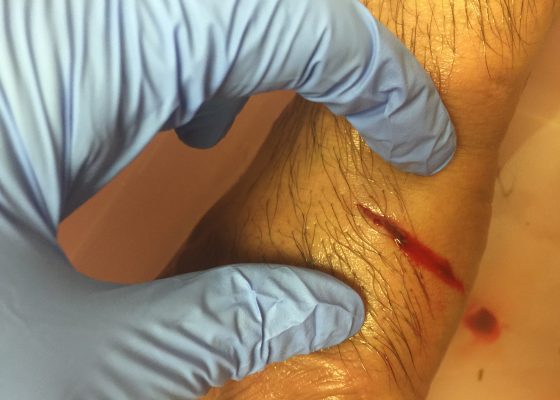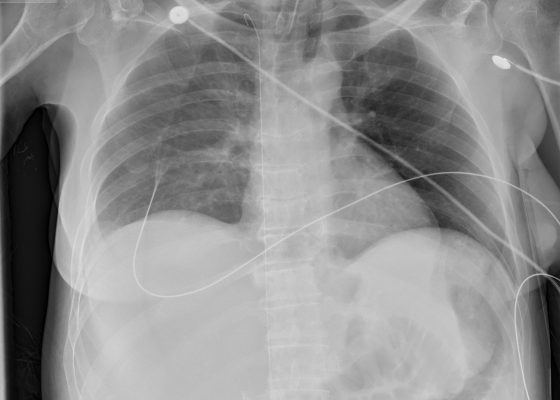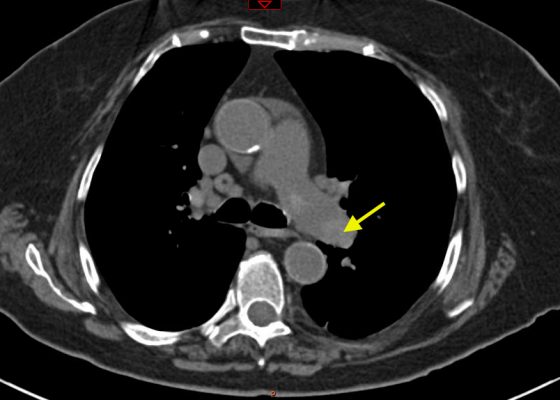Visual EM
Wellens’ Sign (Wellens’ Syndrome)
DOI: https://doi.org/10.21980/J8W30PThis EKG shows deep, inverted T waves that are most pronounced in V2-V4, and are associated with continued T wave inversions in V5 and V6 and ST segment changes in V1-V3.
Herpes Zoster
DOI: https://doi.org/10.21980/J8C301The patient was in mild distress, afebrile, with stable vital signs. His physical exam revealed an erythematous, grouped vesicular rash in various stages of progression including erythematous papules, clear vesicles, and pustular vesicles. Few lesions were scabbed over. No signs of crusting or scarring were appreciated. The distribution encompassed the entire left T4 dermatome both posteriorly and anteriorly. No other rashes were appreciated elsewhere on the body.
Stingray Envenomation
DOI: http://doi.org/10.21980/J86C7WPhysical exam revealed a 3cm laceration to the ulnar side of the dorsum of the left hand with minimal hand swelling. There was no exposed tendon or bone, the hand was neurovascularly intact and had full strength. A small barb was visualized and removed from the injury site. Radiograph of the left hand confirmed that there was no remaining barb (see normal x-ray).
The Lost Guidewire
DOI: https://doi.org/10.21980/J82P4MInitial chest radiograph shows a guidewire in the inferior vena cava (IVC), superior vena cava (SVC), and right IJ veins.
A Toddler with Abdominal Pain and Emesis
DOI: https://doi.org/10.21980/J8XW2PIn the long axis video, the appendix appears as an enlarged, non-compressible, blind-ending tubular structure (white arrow) with distinct appendiceal wall layers and lack of peristalsis. In the short axis video, the appendix appears as a target sign (yellow arrow) between the abdominal and psoas muscles. The maximal outer diameter (MOD) measures 11.8mm and the appendix wall measures 0.17mm. There is trace adjacent free fluid and echogenic periappendiceal fat. Transverse axis video and image (red arrow) demonstrate that the appendix is not compressible. These findings are consistent with acute appendicitis.
An Elderly Female with Dyspnea and Abdominal Pain
DOI: https://doi.org/10.21980/J83S3KRadiography shows a dilated, gas-filled structure that fills nearly the entire left hemi-thorax. Lung markings are visible in the uppermost portion of the left hemi-thorax. There is mediastinal shift to the right. In the visualized portion of the abdomen, dilated loops of bowel are also visualized. This constellation of findings is consistent with a tension gastrothorax.
Pulmonary Embolism: Diagnosis by Computerized Tomography without Intravenous Contrast
DOI: https://doi.org/10.21980/J8001ZNon-contrast CT of the chest demonstrates hyper-densities within both central and sub-segmental pulmonary arteries bilaterally (see yellow arrows). The right ventricle is dilated.
Irreducible Traumatic Posterior Shoulder Dislocation
DOI: https://doi.org/10.21980/J8V884Radiographs demonstrated posterior displacement of the humeral head on the “Y” view (see white arrow) and widening of the glenohumeral joint space on anterior-posterior view (see red arrow). The findings were consistent with posterior dislocation and a Hill-Sachs type deformity. Sedation was performed and reduction was attempted using external rotation, traction counter-traction. An immediate “pop” was felt during the procedure. Post-procedure radiographs revealed a persistent posterior subluxation with interlocking at posterior glenoid. CT revealed posterior dislocation with acute depressed impaction deformity medial to the biceps groove with the humeral head perched on the posterior glenoid, interlocked at reverse Hill-Sachs deformity (see blue arrow).
Pseudogout and Calcium Pyrophosphate Disease
DOI: https://doi.org/10.21980/J8QG66Radiographs of the knee showed multiple radio-dense lines paralleling the articular surface (see red arrows) consistent with calcium pyrophosphate crystal deposition within the joint often seen in calcium pyrophosphate disease (CPPD) also known as pseudogout.
ST Elevation in aVR with Coexistent Multilead ST Depression
DOI: https://doi.org/10.21980/J8KS3XThe ECG shows ST-segment depressions in precordial leads V3 through V6, and limb leads I, II, and aVL, and 1 mm of ST-segment elevation in aVR. The initial troponin I was elevated at 1.37 ng/mL (upper limit of normal 0.40). Cardiology decided to delay catheterization until the next day when diffuse coronary disease was discovered (including 90% of the left circumflex stenosis, 60% proximal and 75% mid-left anterior descending stenosis, 75% third diagonal branch stenosis, and 90% posterior descending artery stenosis). The following day, the patient went to the operating room for coronary artery bypass grafting (CABG).










